In the era of social media platforms like Douyin, preserving the essence of traditional Chinese culture while adapting it to contemporary trends is crucial for its continued relevance and vitality. This paper delves into the practical implications of leveraging social media for cultural communication, emphasizing communication strategies tailored to platforms like Douyin. It introduces two novel algorithms for generating Douyin information dissemination trees: one based on retweeting relationships and another optimized for rapid dissemination. Comparative experiments assess the performance of these algorithms and analyze the node distribution within dissemination trees, aiming to enhance the dissemination power of traditional culture and foster its inheritance and innovation.
Chinese traditional culture is profound, has a long history and is rich in philosophy. In the era of douyin, the prosperous development of social media has provided a new platform and more channels for traditional culture to be disseminated, which has led to the diversification of traditional culture dissemination [1]. On the one hand, people are no longer “dependent” on a certain media for information, and more and more consumer groups are living in a mobile state [2,3]. Traditional media has a long communication cycle, poor interactivity, old-fashioned communication methods, and a single communication channel, while (mobile) social media not only meet the audience’s media needs, but also make them media-dependent; on the other hand, the communication content is not innovative enough, lacking in attractiveness, and not targeted enough to arouse the audience’s interest, and many young people are proud of foreign culture, pursuing Japanese and Korean lifestyles, and seeing Chinese Many young people take pride in foreign culture, pursue Japanese and Korean lifestyles, and regard Chinese traditional culture as outdated, obsolete and old-fashioned, and there is a fault in the transmission of Chinese traditional culture. Therefore, it is of contemporary significance to explore the use of social media to disseminate China’s excellent cultural traditions, in order to broaden the breadth and tap the depth of traditional culture dissemination [4,5].
Social media dissemination of Chinese excellent traditional culture for the masses means to be close to life, close to the public, and to take root in the hearts of the public with easily understandable language, more infectious expression, and in a way that is readily accepted [6,7]. Therefore, the dissemination of excellent traditional culture on social media should be open to ideas and active exploration. Reasonable excavation and development of traditional cultural IP, to create a pro-people cultural products. Take the Forbidden City as an example, to “cold”, “authority” to “warm”, “naive” image, from the content and communication form of innovation, play the advantages of social media, targeting young people, successively to the “soft and moe” body, Ming Chengzu Zhu Di Rap H5, humorous and funny paragraph screen friends, layout WeChat public number matrix, douying, QQ platform, micro-expression packs, successively developed online “twelve beauties of the forbidden city” “Forbidden City auspicious” “Emperor’s day” and other APP, the design of the top of the official hat umbrella, “by order of business” card and other interesting creative goods, cell phone cases, chargers, refrigerator stickers and other full of life creative products, attract more young people began to understand the story and culture of the Forbidden City, the Forbidden City from the cross-border creativity has gained a super high popularity (the Forbidden City Taobao has 32.6 million fans and 100,000+ readers of its public articles) and economic benefits from cross-border creativity [8]. The success of the Forbidden City can provide good ideas for us to inherit good traditional culture – based on the culture itself, starting from the user, finding the pain points of the main audience groups, and digging the highlights of the culture that people are most interested in [9,10].
Compared with the one-way transmission of knowledge-based programs on TV, communicators in the social media era emphasize “sharing” and “interaction”, and social activities are conducted on the basis of trust and tacit understanding as equals. Contrary to the popular weblebrities that rely on foul language, popularity and vulgarity, traditional cultural weblebrities with deep roots are more capable of long-term development, meeting the spiritual and cultural needs of the public and having their own fan base [11]. Is Art Hard? The popularity of online video programs such as “Logical Thinking” and “Xiao Song Qi Chuan” has won fans by bringing knowledge and the public closer together with easy-to-understand explanations and humorous and relaxed entertainment on the one hand, and satisfying the public’s realistic demand for traditional culture under the traditional culture demand segmentation on the other.
Social media is a platform for content production (UGC) and exchange based on user relations on the basis of douyin technology and ideology, a tool and platform for people to share their opinions, insights, experiences and views with each other, which has completely changed the way of media content production and dissemination. Social media gives everyone the ability to create and disseminate content, and the audience has the right to speak, and is no longer dominated by the communicator. The advantages of social media are as follows:
short and fast dissemination time, users can quickly obtain a large amount of information;
no time and space restrictions, the communication between users is decentralized, and can spread a large amount of information such as excellent Chinese traditional culture;
cross-platform communication, as more and more consumer groups show the characteristics of mobile life, social media will connect the traditional Internet and mobile Internet to synchronize, and keep in touch with users at all times; and It is easy to produce fan effect [12,13]. The existence of “fans” in large quantities is dependent on the development of popular culture and media technology, and “fans” are the followers and consumers of idols.
Unlike traditional social networks where information is the main source of information, social media such as douyins rely on human friendships to spread information, so the structure between users plays a crucial role in the information dissemination process. The Little Red Book’s users influence the spread of information through the relationships between individual users, and its retweeting feature allows people to learn about information while also having a clear understanding of where it came from, making it easy for users to find the initial point of dissemination. In The Little Red Book, each user has a certain number of followers and can also follow people they are interested in, i.e., become a follower of that person, thus establishing a friend relationship. The information posted by the user is broadcasted to each follower, who can decide whether to retweet it or not when they receive it.
When a user logs into The Little Red Book, he can click on a tweet to
see all the retweets it has caused. Therefore, we can parse the web page
to get a list of all retweets of a tweet. Sina handles the retweets in
the following way: the retweet list of the most original tweet can get
all the retweets (including the retweets caused by its retweets, which
are counted in its root node). The details are shown in Figure 1. Node A
is the original tweet, and its retweet list includes nodes
Input: Original tweet node.
Output:Twitter information dissemination tree map
GENERATE_TREE(Tree Node parent);
list
ADD_CHILD(parent, list);
ADD_CHILD(Tree Node parent, List
Tree Node old_parent
add children
map.put( children
children
UPDATE_CHILD_PARENT(parent, children
GENERATE_TREE(children
recursive child node
The propagation tree generation process under this algorithm for the example shown in Figure 1 and 2. The list of The Little Red Book retweets is arranged in reverse order according to the retweet time, i.e., the later the retweet time is, the more advanced the child nodes are.

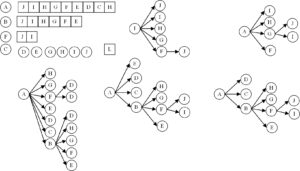
The complexity of this algorithm is analyzed as follows: From the
pseudo-code of this Algorithm 1, it is clear that the operations within
the for loop are all
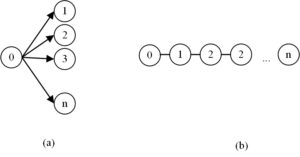
The information dissemination tree generated using the above algorithm is fully consistent with the retweets of The Little Red Book users. As a result, the information dissemination on the red book social platform can be well observed and the social opinion can be better grasped[15,16].
Now, if we only get all the nodes that retweeted a certain tweet and the mutual following relationship among them, but not the corresponding retweet list, how to generate the propagation tree of this tweet? In this case, this algorithm tries to provide a solution. The main basis of this algorithm is that if there are several nodes in the propagation tree that a node follows that retweeted the tweet before the node retweeted the tweet, then the node most likely retweeted the tweet from the node that retweeted the tweet last (i.e., the node that is closest in time to the node)[17].
Algorithm description: Firstly, we store the nodes that retweeted a tweet in ascending order according to their publication time in the status list, and store the first node that published this tweet as the root node in the tree_node_set, then traverse the status list to find the followers of the node friend_set, and then intersect friend_set and tree_node_set. then intersect friend_set and tree_node_set to get the intersect_set liste[18]. At this point, if the intersect_set list is not empty, the node with the latest tweet posting time is selected as the root node and inserted into its child set, otherwise the node is inserted into the root’s child set, and finally the node is inserted into the tree_node_set list. The pseudo code is shown in Algorithm 2:
Input: All the nodes in the douying tree.
Output:Twitter dissemination tree.
GENERATE_TREE(List SL);
list
root
define tree_node_set; // all nodes of the tree are put into this set;
tree_node_set. add(root);
friend_set
intersect_set
find the intersecting set;
Select the point with the latest posting time as the root node and
insert SL
insert SL
tree_node_set. add(SL
Suppose
This algorithm is an approximation of the propagation tree generation in a special case, and it does not guarantee 100% correctness, but the similarity between this algorithm and the real propagation tree has been confirmed by a large number of experiments to be more than 80%. Compared with the propagation tree generation based on douyin retweet list, the accuracy of this algorithm is reduced, but the speed of tree generation is greatly improved, which is suitable for the case where the accuracy of the propagation tree is not high, but the generation time is high. It is suitable for use in cases where the accuracy of the propagation tree is not high, but the generation time is high[19].
According to the visualization of information dissemination on The Little Red Book [20] into a dissemination tree, we can clearly see the occurrence of some more typical situations. In this paper, we list several typical information dissemination tree models, such as single node explosion type information dissemination tree, high influence node secondary outbreak type information dissemination tree, information confrontation douyin information dissemination tree and multi-point contention type information dissemination tree, which I have observed through numerous experiments, see Figure 4.
As shown in Figure 4, culture can it come to an updated way of communication, through the Cantonese opera live broadcast room, or even a small cultural live competition can be held to increase the heat of Cantonese opera culture. The classic stories of Cantonese opera are presented through the form of live streaming to create a cultural story belonging to Cantonese opera live streaming, so that more young people groups will not only be exposed to Cantonese opera culture, but also feel the values of traditional Cantonese opera culture, and thus enhance the interest of young people groups in Chinese culture. Moreover, the live broadcast also supports the novel pop-up function, which allows audiences to comment and communicate in real time on the live content and interact with the anchor, and as a new type of feedback channel, it will engage more young audiences while being able to eliminate stereotypes of the way Cantonese opera culture is disseminated [].
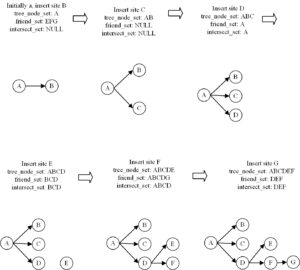
As shown in Figure 5, the rapid development of cell phone smart devices has provided unlimited possibilities for the design of mobile APPs so that people who love Cantonese opera culture not only sit in front of the TV set and play the role of audience, but also as participants in promoting the spread of Cantonese opera culture. By providing relevant Cantonese opera information through mobile APPs, people are kept abreast of the latest developments in Cantonese opera and remain at the forefront. Mobile APPs can cover a wide range of information, such as Cantonese opera audio appreciation, Cantonese opera knowledge and commentary, Cantonese opera performance information events, and even expand into more entertaining functions, such as Cantonese opera chat rooms where Cantonese opera co-lovers can learn and communicate with each other, allowing senior enthusiasts to answer questions from novice enthusiasts so that they no longer need to search for boring information; sing along recordings, by participating in singing and recording and uploading ratings The online Cantonese opera singing competition is held regularly to promote the development of Cantonese opera to a certain extent; the introduction of face painting games, etc., has won the favor of more young users and set off a trend of education and fun in the society [22].
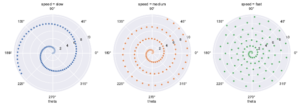
With the development of technology, digital media is growing at an amazing pace and has become indispensable in people’s lives. Among them, social media, as a product of technological development, is driving culture, penetrating culture, interpreting culture, and at the same time trying to lead culture. It is not receptive, but participatory and experiential. For the traditional culture of Cantonese opera, how should we use mobile social media to innovate the way of communication of traditional culture? Figure 6 shows a single-node explosive information dissemination tree, in which the first level has the most retweets, accounting for almost 80% of the retweets. The second and subsequent layers are relatively few, and the number of layers is not deep enough. As shown in Figure 6, the information dissemination tree of high-influence nodes is of the second burst type, which shows that after an opinion leader publishes a tweet, several other opinion leaders publish tweets, bringing about second or even multiple retweets and further expanding the influence of the event. As shown in Figure 6, this is a confrontational information dissemination tree, which often shows people from two camps re-tweeting each other when they encounter divergent issues. As shown in Figure 6, a multi-point contention type information dissemination tree is shown in which a user posts a douyin, which can attract the participation of multiple opinion leaders on the Internet, covering a wide range of people and being retweeted by the majority of Internet users.
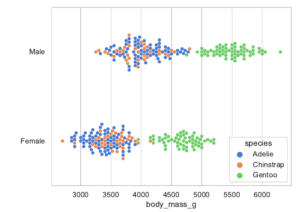
We experimentally counted the distribution of layers of 2,000 douyin dissemination trees (above 1,000 nodes), and some of the data are shown in Table 1. The line graph obtained from the data in Table 1 is shown in Figure 7.
| Number of layers | 1 | 2 | 3 | 4 | 5 | 6 | 7 | 8 | 9 | 10 | 11 | 12 | 13 | 14 | 15 | 16 |
| Number of node | 23 | 116 | 113 | 168 | 319 | 362 | 267 | 153 | 96 | 46 | 40 | 23 | 11 | 4 | 3 | 5 |

Figure 7 shows that the number of douyin propagation trees increases and then decreases as the number of layers increases. When the number of layers is less than 6, the number of propagation trees tends to increase as the number of layers increases; when the number of layers reaches 6, the number of propagation trees reaches the peak; after that, the number of propagation trees gradually decreases as the number of layers increases [18]. It can be seen that the number of layers in a certain size of propagation tree (above 1,000 nodes) is around 6, which is consistent with the conclusion that the average number of layers in a propagation tree is 6.21 [19]. In theory, the number of layers in the tree should increase as the number of nodes grows. In this regard, we randomly selected 3,000 propagation trees for the experiment, and the results are shown in Table 1.
| Number of nodes | 0-500 | 500-1000 | 1000-1500 | 1500-2000 | 2000-2500 | 2500-3000 |
|---|---|---|---|---|---|---|
| Average layer | 2.32 | 5.33 | 5.98 | 6.55 | 7.11 | 7.13 |
| Number of nodes | 3000-3500 | 3500-4000 | 4000-4500 | 4500-5000 | 5000-5500 | 5500-6000 |
| Average layer | 7.85 | 9.50 | 9.62 | 9.22 | 9.45 | 11.13 |
As shown in Table 2, the number of layers of the douyin propagation tree tends to increase with the number of nodes, which is consistent with the prediction. However, it can also be seen that the growth of the number of layers of the douyin tree slows down as the number of nodes grows to a certain level.
The new media such as WeChat, douyinging and live-streaming software are used to broadcast the archaeological work in Yuanmingyuan Ruins Park, allowing more people to watch and understand the archaeological work “up close and personal” on the Internet. Based on the development of social media, this paper explores the practical significance of using social media for communication and its communication strategy, the generation algorithm of douyin information dissemination tree based on retweeting relationship and a fast douyin information dissemination tree generation algorithm. Through experiments, the performance of these two algorithms is compared, and the node distribution of the dissemination tree is analyzed. With a unique interactive experience and a novel and lively form of dissemination, it evokes the demand of young people for traditional culture, attracts favorable comments and retweets from netizens, and finds more young audiences for Chinese traditional culture.
This study was supported by the “2022 Higher Education Science Research Planning Project” of the Chinese Higher Education Association, “Research on Effective Governance of Big Data in Higher Education Teaching” (Project approval number: 22XX0417).
The authors declare no conflict of interests.
1970-2025 CP (Manitoba, Canada) unless otherwise stated.